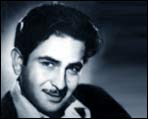
![]() Festivals
Festivals
![]() Durga Puja
Durga Puja
![]() Associations
Associations
![]() Learn
Bangla
Learn
Bangla
![]() Beng.
Marriage
Beng.
Marriage
![]() Art &
Craft
Art &
Craft
![]() Great Indians
Great Indians
![]() Beauty
Care
Beauty
Care
![]() Recipe
Recipe
![]() Astrology
Astrology
![]() Beng.
Section
Beng.
Section
![]() Bengal
Bengal
![]() Calcutta
Calcutta
![]() Beng.
Calendar
Beng.
Calendar
![]() Wallpapers
Wallpapers
![]() Movie
Movie
![]() Music
Music
![]() E-Card
E-Card
![]() Shopping
Shopping
![]() E-Puja Room
E-Puja Room
![]() News
News
![]() E-mail
E-mail
![]() Month's Events
Month's Events
![]() Weather
Weather
![]() Chat
Chat
![]() Education
Education
![]() Join Us
Join Us
![]() Advertise
Advertise
![]() Website links
Website links
![]() Link to us
Link to us
![]() Guest Corner
Guest Corner
![]() Services
Services
![]() WebSite
Design
WebSite
Design

One of the most influential actors and directors of Indian films, Raj Kapoor was appreciated both by film critics and ordinary film. Film historians and movie buffs speak of him as the "Charlie Chaplin of Indian cinema," since he often portrayed a tramp-like figure, who despite adversity, was still cheerful and honest. He had a master's touch for
His fame
spread world-wide. He was adored by audiences in large parts of Africa,
the Middle East and the former Soviet Union.
Raj Kapoor was born on 14th December 1924, at Peshawar in the North-West
Frontier Province of what is now Pakistan. He was named Ranbirraj Kapoor
at birth, and was the eldest of the four children of renowned stage and
cinema actor Prithviraj Kapoor and his wife Smt. Ramsarni Devi. His younger
brothers were the actors Shammi Kapoor and Shashi Kapoor.
Raj Kapoor grew up surrounded by Indian film. Raj Kapoor began his career
as a clapper boy assisting Kidar Sharma. He also assisted such leading
Indian directors as Amiya Chakravarty, and Sushil Majumdar at the Bombay
Talkies Studio.
At age eleven, he made his film debut in 1935 called Inquilab. After that
Kapoor acted and sang in many plays at the Prithvi Theater. Raj Kapoor's
big break, however, came when he played the hero's role in Neel Kamal
(1947) by Kidar Sharma.
In 1948, at the age of twenty-four, he established his own studio, R. K. Films, and became the youngest film director of his time. His first movie as a director Aag (Fire) (1948) was an immediate success. The film marked the first time he worked with actress Nargis. For the next decade, they continued to work together. Kapoor starred in numerous box office hits including Barsaat in 1949, to Awaara (1951), Shree 420 With Awaara, Raj Kapoor created the Chaplinisque tramp, an allegory for the innocent state of mind of the post Independent Indian. This image was used once again in Shree 420 (1955) tracing the corruption of an innocent soul who comes to the city to make his living. Raj Kapoor continued to explore social issues in his Jis Desh Mein Ganga Behti Hai (1960) or complex human relationship in his next hit Sangam, his first film in color (1964). Reverting back to the Chaplinisque image, Kapoor made his magnum opus Mera Naam Joker (1970) about a clown. A three-hour-long social comedy that had taken nine years to film, was a commercial flop.
Although he continued to act in his films, Mera Naam Joker was his last outing in a leading role. Beginning with his 1973 film Bobby, a tale of teenage love, Kapoor's movies reflected sexually explicit views. The film Bobby (1973) introduced a new generation of teen romances. Raj Kapoor trafficked in boundary-pushing sexuality in later films like Satyam Shivam Sundaram (1978) and Ram Teri Ganga Maili (1985) with exceptions like Prem Rog (1982) based on widow re-marriage.

Raj's films have explored duality - Aag looked at Physical beauty v/s
Inner beauty (a theme revisited in Satyam Shivam Sundaram (1978)), Barsaat
(1949) looked at Love v/s Lust, Mera Naam Joker (1970) at Public life
v/s Private life etc.
Raj Kapoor suffered from asthma in his later years. He died of complications related to asthma in 1988 at sixty-three years of age.At the time of his death he was working on the movie Henna (an Indo-Pakistani love story). The film was later completed by his son, Randhir Kapoor.

He used
striking visual compositions, elaborate sets, and dramatic lighting to
complete the mood set by the music.
He introduced the actors Nimmi, Dimple Kapadia, Zeenat Aman and Mandakini,
as well as fostering the careers of his sons Rishi and Rajiv.
Raj Kapoor was given the Dadasaheb Phalke Award in 1987, for lifetime
commitment to Indian cinema.
GREAT INDIANS || BENGALI SECTION || BENGALI MARRIAGE || WALLPAPER || BENGAL || WEATHER || E-CARD
MOVIE || WEBSITE LINKS || ASSOCIATIONS || SHOPPING || ASTROLOGY || MUSIC || BEAUTY CARE || NEWS
GUEST CORNER || FEEDBACK ||LINK TO US || FOR ADVERTISING || SERVICES || CONTACT || EDUCATION || JOIN US
Graphics, Sound or content copied or produced in part or whole in any media will be illegal.
Persons or websites caught using our material will be penalized.
Privacy Statement || Copyright
Copyright ©1999-2014 BANGALINET.COM